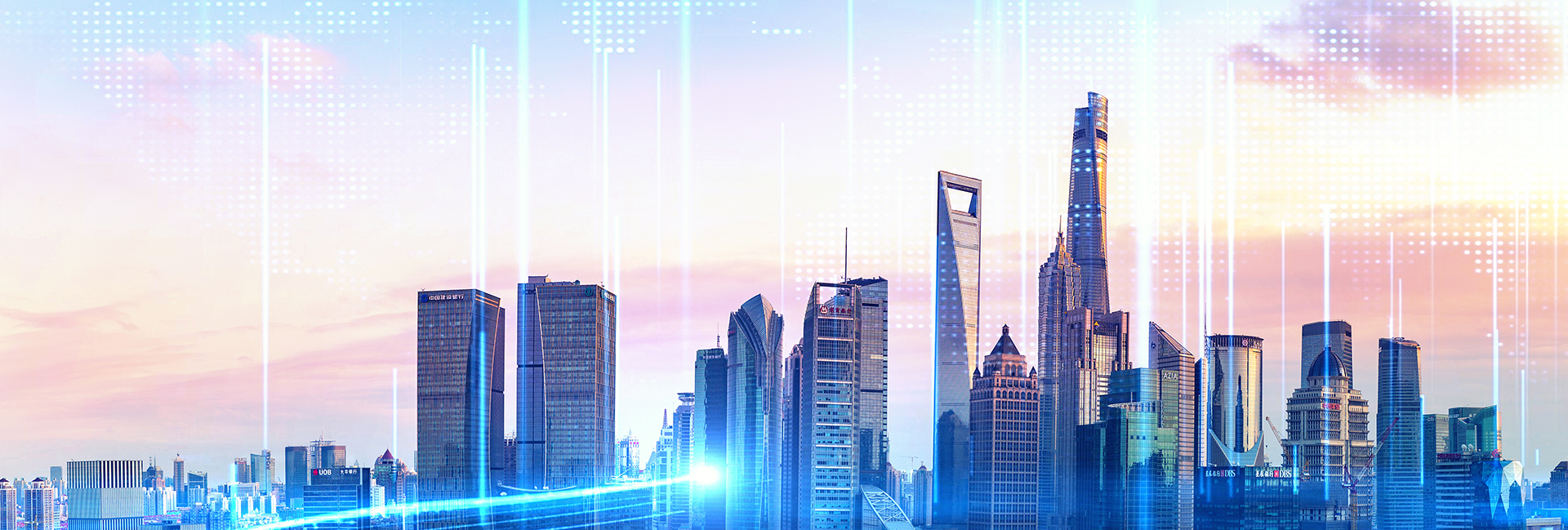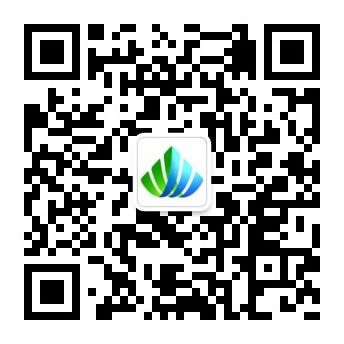Urban Intelligence Brain
-

Fields of Application
Digital Government and Smart Cities
-

Solution Overview
By integrating the city's existing information systems and data resources, the Urban Intelligence Brain integrates cloud computing, big data, artificial intelligence, digital twins, converged communications, and the Internet of Things to build a converged and interpenetrating city-level digital platform. It is also combined with the transformation of the city's operating system, through the integration of technology and industry business, and forms a hub for gathering data, refining knowledge, coordinating command, and supporting city-level information sharing, business collaboration, and integration and innovation. The Urban Intelligence Brain is like the human brain, learning about the operation of the world by integrating information from various senses in the body. By accumulating experience in various aspects, it forms a cognition of affairs, combines information in all aspects, makes analysis and judgment in advance, and commands various parts of the limb to make a coordinated response.
-

Solution Highlights
The Urban Intelligence Brain integrates technologies such as cloud computing, big data, artificial intelligence, digital twins, converged communications, and the Internet of Things. By integrating the city's existing information systems and data resources, it forms a converged and interpenetrating urban-level digital platform, further eliminating vertical industry barriers, making the city's production, life, governance, and services more organically integrated, and thus better supporting the city's operation of "one map overview", "government affairs" batch processing in seconds", public services "all in one mobile portal", urban governance "all on one website", the emergency command "integrated collaboration", and other activities to promote the digital transformation and upgrading of various industries, and build a new smart city operating system featuring "centralized construction, vertical and horizontal connectivity, business collaboration, and intelligent applications ".
-

Solution Architecture
The Urban Intelligence Brain is the product of the integration of information technology and urban governance models. From a technical point of view, it is a city-level digital platform that combines big data, artificial intelligence, spatial-temporal information, the Internet of Things, video, and converged communication. It breaks the previous self-contained information construction model of various departments. Each system is no longer independently built as in the past, or peer-to-peer interacts with other systems. Instead, it shares data, calls on services, and interacts with the Urban Intelligence Brain to build the frontend of the "people-centered" business applications, form workflows for cross-department collaboration, and respond to changes in business needs. From a business perspective, the Urban Intelligence Brain is the "central system" of the city's integrated operation. It integrates technology with the business of various fields, provides "perception, data, cognition, and collaboration", forms a service capability that integrates perception, analysis, reasoning, decision-making, and action, and completes specific tasks in the business field in a highly coordinated manner, enabling business innovation in various departments.
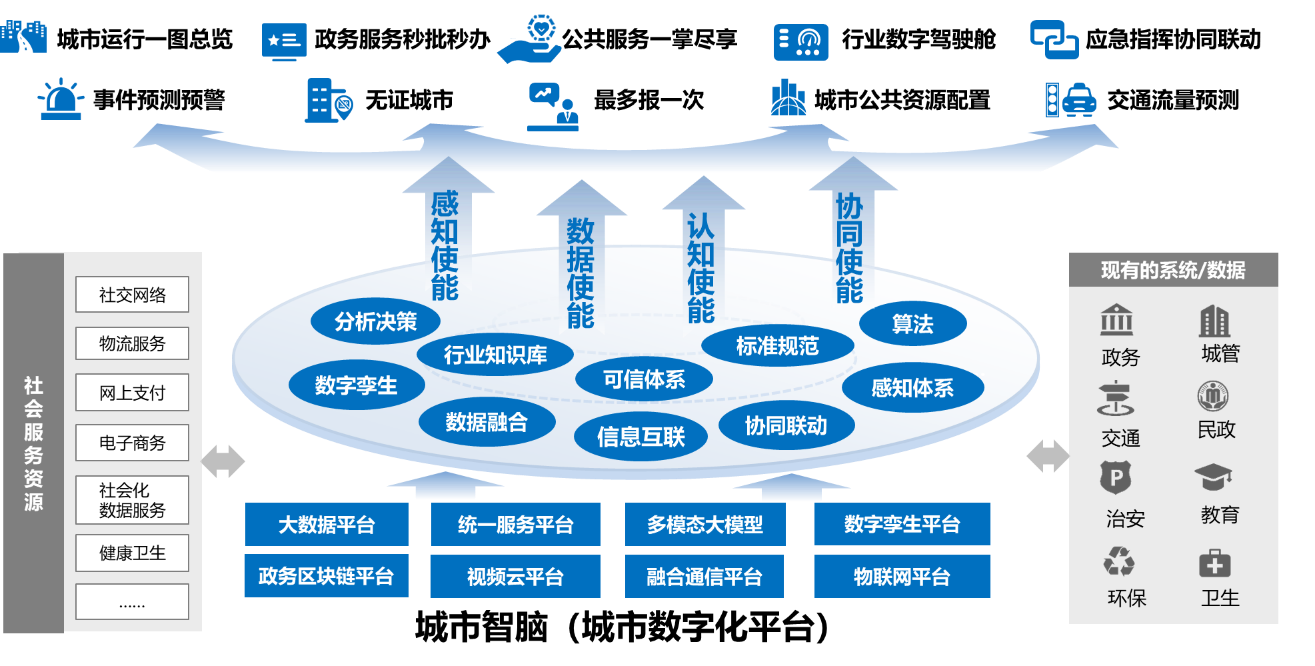
-

Business Value
1. Provide a unified technical architecture to support the modern urban operation system
Give full play to the role of connecting, integrating, sharing, and publishing as an urban digital platform, provide support for various departments to improve the business model, and achieve the overall operation effect of "data sharing, business collaboration, top-down and bottom-up communication, and block linkage".
2. Undertake the link between the real world and the digital city
Comprehensively apply the next-generation information technology, establish a "digital city" (digital twin city) corresponding to the real world, clearly display the overall picture of the city's operation state, and promote the transformation and upgrading of the real world’s operation mode.
3. Improve the overall operation and management level of the city
Through intensive management of the city's data resources, especially the use of video surveillance, Internet of Things data, spatio-temporal big data, and real-time APIs of various departments, the Urban Intelligence Brain can achieve dynamic perception and overall coordination of the city's operating conditions, effectively improving the modernization, intelligence, and collaboration level of urban management.
4. Data drives business decisions and promotes digital transformation in various industries
Based on the multi-modal large-scale models, Urban Intelligence Brain can optimize and reshape government affairs processes and improve service quality and user experience. For example, in the field of smart government affairs, with video recognition, speech and semantic understanding, and other technologies, people can consult intelligent customer service for various issues, and automation can replace manual approval services, etc., to truly achieve "no running around for errands" and "instant approval".
5. Implement the "people-oriented" approach and build innovative application scenarios
On the basis of gathering various information resources, Urban Intelligence Brain integrates business and technology with the needs of the public and enterprises to form an innovative business operation model, further improve the level of precision and convenience of urban services, and continuously enhance the sense of access and happiness of the public and enterprises. -

Application Scenarios
Based on the data fusion, modeling, analysis, visualization, and other capabilities provided by the Urban Intelligence Brain, we can make full use of the information resources of various industries and departments in the city, quickly and flexibly build cross-domain integrated and innovative intelligent applications, and form innovative application scenarios such as "urban operation overview, digital cockpit, intelligent customer service for government affairs, urban lifeline monitoring, unified online urban governance, and emergency management collaboration".
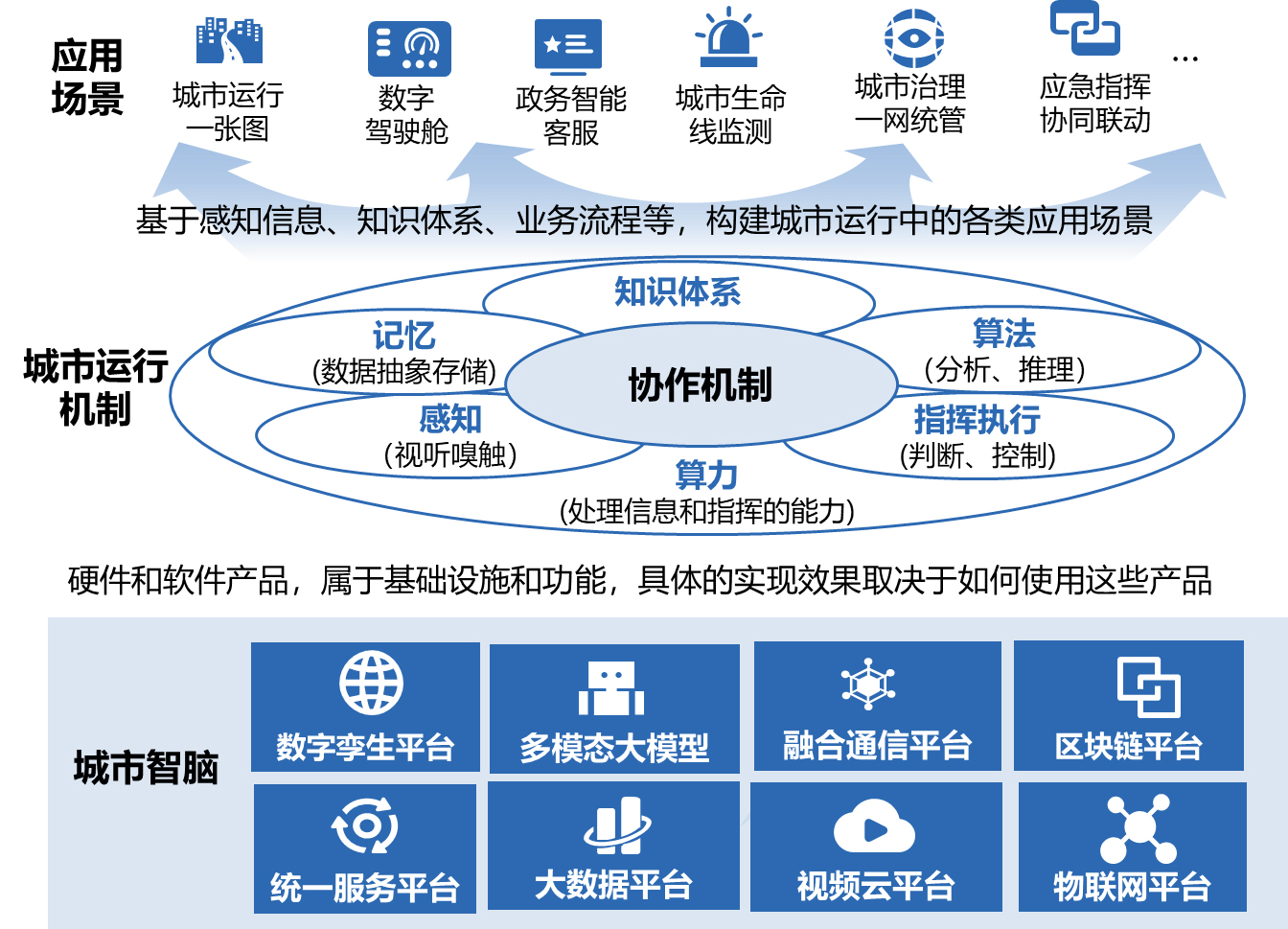
Operation mode of the Urban Intelligence Brain and its application scenarios
-
Scenario 1: Urban Operation Overview
Urban Intelligence Brain brings together big data, video, the Internet of Things, spatio-temporal information, and other information resources to present the operation of the city in real time on a digital twin map. For example, it accurately presents the distribution of various resources in the city on a three-dimensional map, including buildings, schools, hospitals, enterprises, buildings, reservoirs, etc., combines real-time information such as surveillance footage, the Internet of Things, and other information on various events to form business scenarios in various fields, and helps managers of various departments to have an overview the overall situation of the city to understand the business operation status.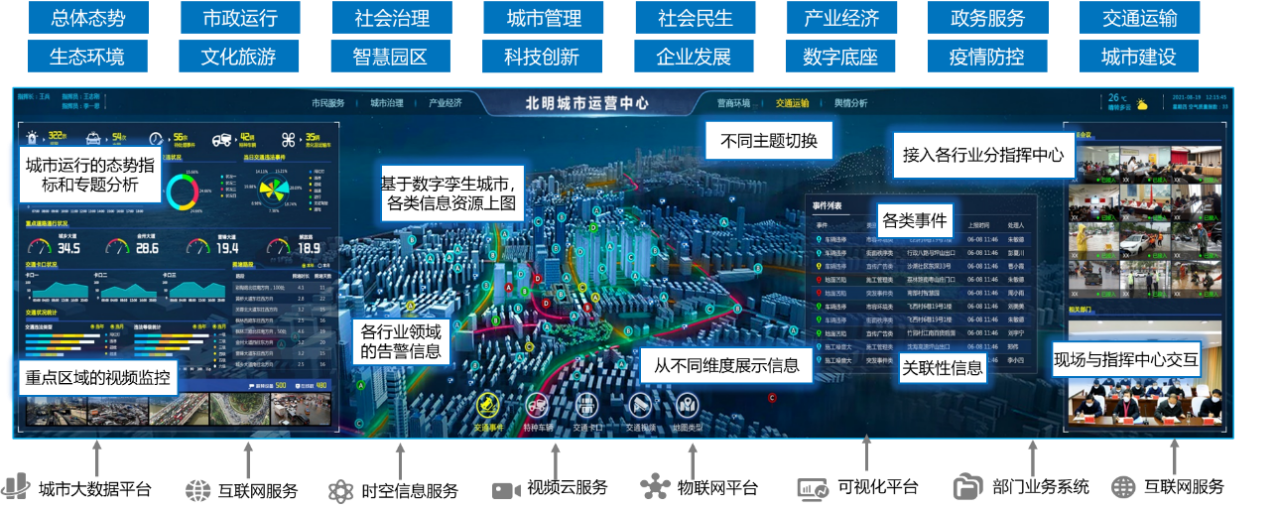
Scenario 2: Assisted Decision Making in Digital Cockpits
On the basis of aggregating various types of information in the city, the Urban Intelligence Brain integrates, reconciles, classifies, and cross-references the data of various departments in each field, builds an algorithm model, carries out monitoring, planning, early warning, prediction, and other analysis activities, and provides visual data display and interaction in the digital cockpit, providing multi-dimensional and in-depth business analysis and auxiliary decision-making support for each department.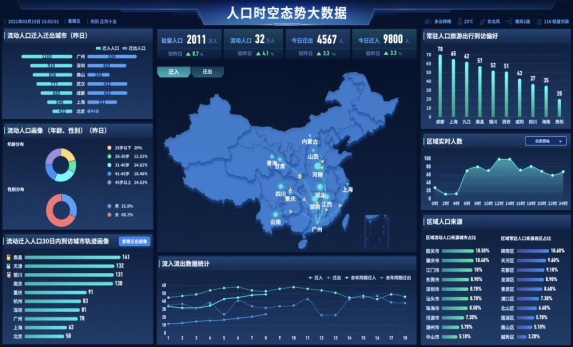
Scenario 3: Intelligent Customer Service for Government Affairs
Built on the Urban Intelligence Brain, it relies on the multi-modal large model to learn and master a large amount of knowledge in the field of government services, which can more accurately understand the user's questioning intentions, answer various government affair issues in a way that is closer to human communication, and provide more comprehensive information services. Using algorithms and tools such as search enhancement and reasoning enhancement, intelligent customer service, it can skillfully respond to various complex and personalized chat scenarios, provide users with scientific decision-making suggestions and action plans, and help users complete business appointments, fill out orders, declare items, and other operations through voice communication, greatly simplifying user operations and bringing a more user-friendly interactive experience.Scenario 4: Urban Lifeline Monitoring
Making comprehensive use of technologies such as the Internet of Things, big data, artificial intelligence, and digital twins, the system can dynamically monitor the operation of urban infrastructure such as gas pipelines, water supply and drainage pipelines, bridges, tunnels, and roads, strengthen daily supervision capabilities, and realize thorough perception, risk identification, research and early warning, auxiliary decision-making, and collaborative linkage of urban lifeline safety engineering, so that urban lifeline safety management can move toward the fundamental transformation of "from invisible to visible, post-investigation disposal to early warning prompts and from passive response to active prevention and control".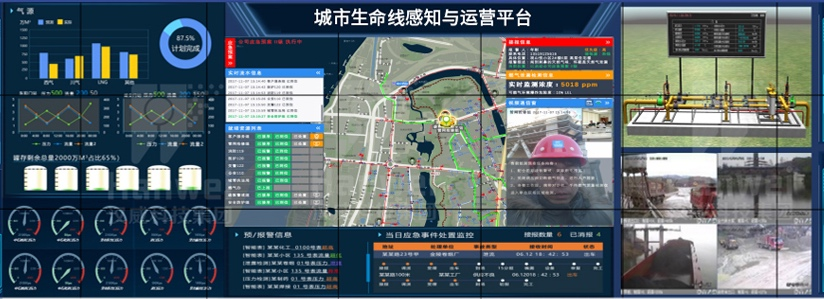
Scenario 5: Unified Online Urban Governance
The Urban Intelligence Brain integrates big data, video networking, spatio-temporal geographic information, converged communication, and other abilities. It is the cornerstone of the One-Stop Management System for Urban Governance. Through the collection of event information from various departments, and the use of digital platforms to optimize the process of matters, a long-term closed-loop operation mechanism for unified acceptance analysis, unified distribution circulation, unified disposal standards, and unified feedback evaluation has been built up. On the basis of real-time, live, multi-dimensional, multi-source, and polymorphic data, new business data streams such as government hotlines, grassroots comprehensive governance, urban management, emergency linkage, flood prevention command, etc., have been set up. With the help of video intelligent identification, semantic analysis, etc., the efficiency of prediction and early warning, hand shooting, positioning, allocation, and disposal has been greatly improved.
Scenario 6: Waterlogging Emergency Management Collaboration
Under the traditional urban management model, when an internal waterlogging incident occurs, each department implements its own emergency plan and cannot collaborate with each other. A risk monitoring and early warning prediction mechanism can be established based on the Urban Intelligence Brain. When the risk of rainstorms is monitored, the impact of rainfall on various waterlogging points, the duration of pumping, and the regional traffic congestion caused can be predicted based on historical data, and decision-making recommendations can be put forward. At the same time, the use of converged communication and other means can speed up the information sharing of various departments and command and dispatch various departments to cooperate in dealing with emergency events. -

Successful Cases
Guangzhou "SuiZhiGuan" Urban Operation Management Center
Smart City of Wuhan, Hubei Province
Smart City of Yiyang, Hunan Province
New Smart City Construction of Langfang, Hebei Province
Smart City of Huangpu District, Guangzhou City, Guangdong Province
New Smart City of Wangcheng District, Changsha, Hunan Province
Smart City of Wugang, Henan Province
New Smart City of Pengxi County, Sichuan Province

